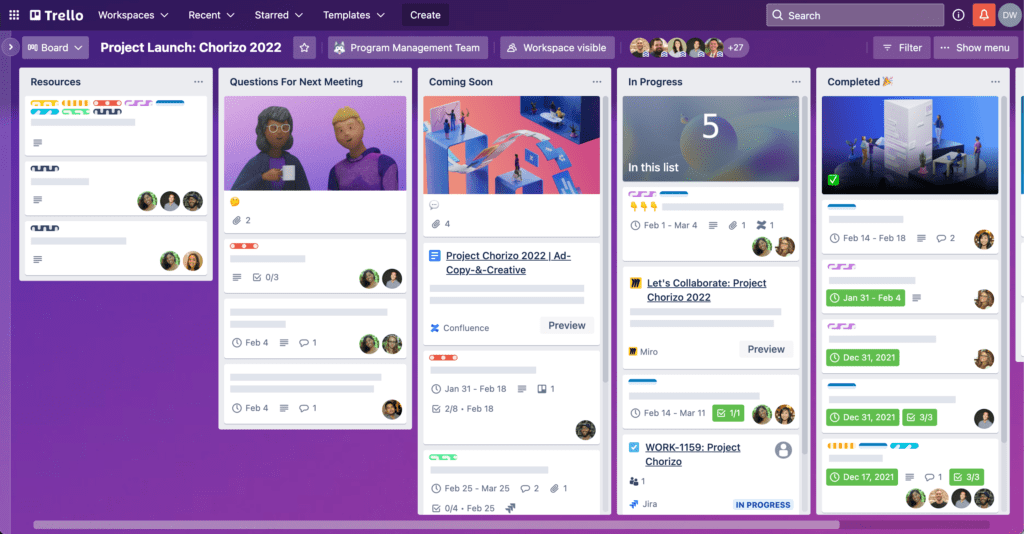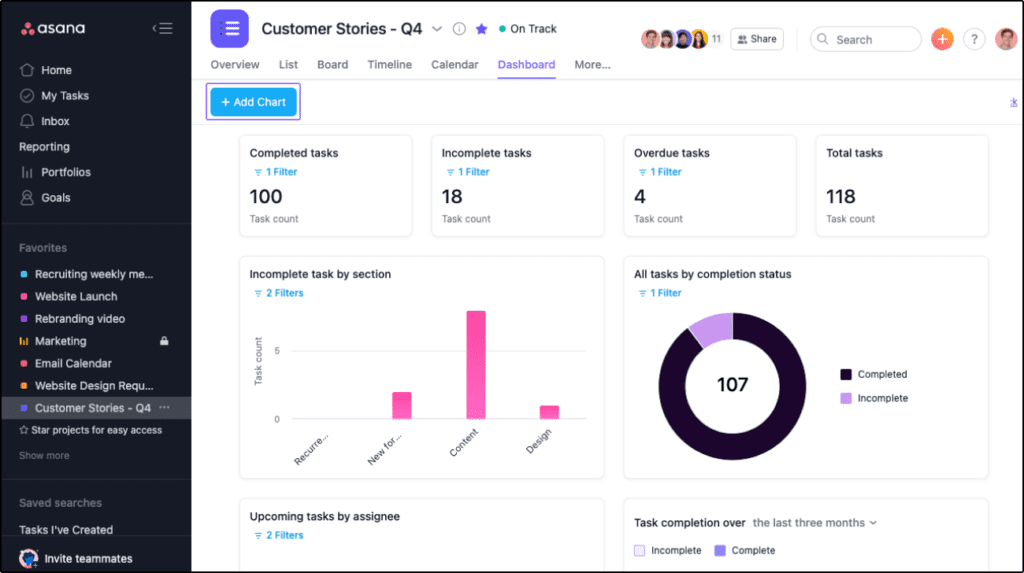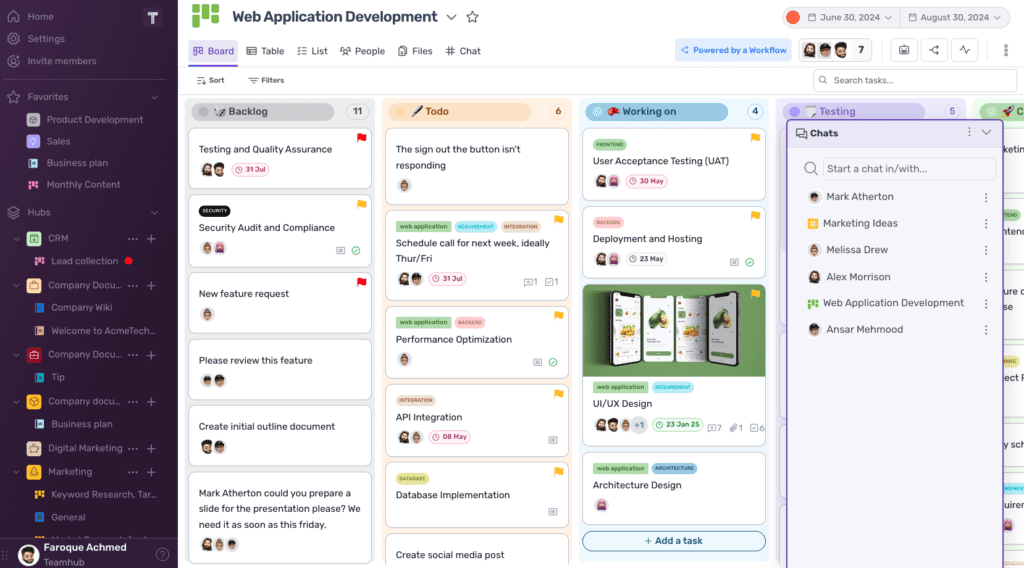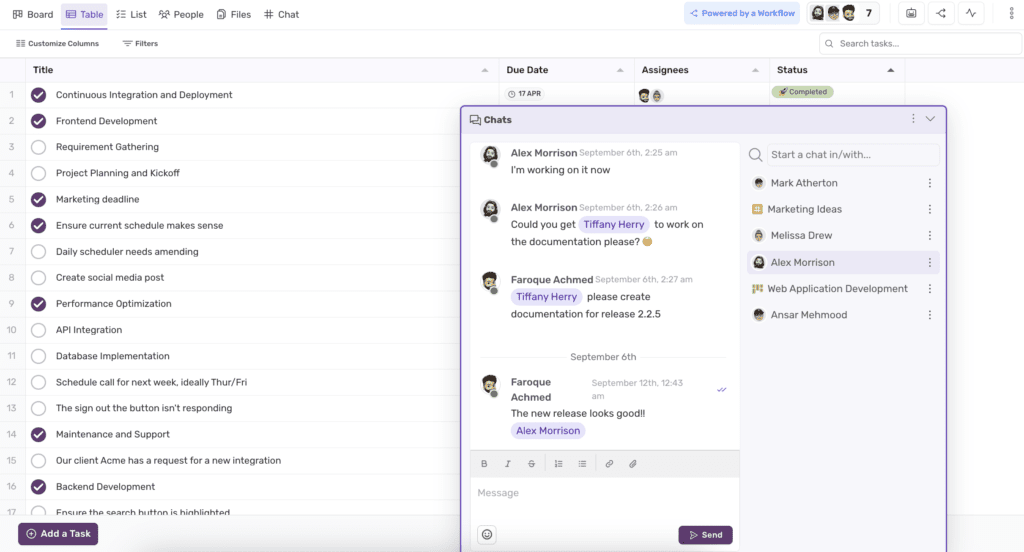Trello vs. Asana vs. Teamhub.com: A Comprehensive Comparison for Project Management Success
As my team began to grow, I quickly recognized that effective project management would be essential for our success. The right project management tool can significantly influence productivity, team collaboration, and the overall trajectory of projects. However, selecting the ideal tool can be a daunting task. What started as a straightforward comparison of a few platforms transformed into a deep dive into their features, usability, and pricing, as each option presented distinct advantages and potential drawbacks.
The Significance of Project Management Tools
Managing projects in today’s environment is akin to navigating a ship through turbulent waters; without a reliable compass, it’s all too easy to veer off course. A robust project management tool can serve as that compass, guiding teams toward their objectives, streamlining processes, and enhancing communication. Through my journey of evaluating various platforms, I discovered that choosing the right tool could foster a culture of accountability and transparency, essential elements in ensuring that everyone is aligned and working toward shared goals.
The digital workspace demands flexibility and adaptability, making it crucial for teams to select a project management software that not only meets their immediate needs but can also grow with them. As I explored the options, Trello, Asana, and Teamhub.com emerged as strong contenders, each boasting unique features tailored to different aspects of project management and team dynamics.
A Detailed Look at Trello, Asana, and Teamhub.com
Trello, Asana, and Teamhub.com are all leading project management platforms, each offering a wide range of functionalities designed to enhance productivity and collaboration. However, their approaches to task management, visual organization, and integration capabilities vary significantly.
Feature Overview
- Trello is best known for its user-friendly, card-based interface, which allows teams to visualize tasks and workflows easily. Its simplicity and flexibility make it an excellent choice for smaller teams or projects that prioritize visual organization. The ability to create boards, lists, and cards ensures that anyone, regardless of their technical skills, can get started quickly. However, as projects become more complex, users might find themselves longing for additional features that Trello lacks, such as robust reporting or advanced analytics.
- Asana takes a more structured approach, offering a suite of tools designed to manage tasks efficiently. With features like task lists, timelines, and boards, Asana accommodates teams of various sizes and project complexities. It supports a wide range of functionalities, including subtasks, dependencies, and timeline views, which make it suitable for tackling intricate projects. While Asana is generally intuitive, it may take some time for new users to familiarize themselves with its extensive capabilities.
- Teamhub.com positions itself as a comprehensive project management solution that merges task management with powerful analytics. Its integrated Data Apps allow teams to access real-time insights into project metrics, facilitating data-driven decision-making. Teamhub.com excels in collaboration by offering built-in communication tools, enabling team members to share updates and ideas seamlessly within the platform, eliminating the need for third-party apps.
A Deep Dive into Feature Comparisons
To help you make an informed decision, let’s break down the key features of each platform in greater detail, comparing their strengths and weaknesses across various categories.
| Comparison | Trello | Asana | Teamhub.com |
|---|---|---|---|
| Free Plan | ⭐⭐⭐⭐⭐ Generous features | ⭐⭐⭐⭐ Limited to basic features | ⭐⭐⭐⭐⭐ 3 users, comprehensive free plan |
| Ease of Use | ⭐⭐⭐⭐⭐ Highly intuitive | ⭐⭐⭐⭐ User-friendly but can be complex | ⭐⭐⭐⭐⭐ Clean interface, highly navigable |
| Automation | ⭐⭐⭐ Limited automations via Power-Ups | ⭐⭐⭐⭐⭐ 100 tasks/month on free version | ⭐⭐⭐⭐⭐ Unlimited automations available |
| Time Tracking | ⭐⭐ No built-in tracking | ⭐⭐⭐ Requires third-party integration | ⭐⭐⭐⭐⭐ Built-in time tracking across all plans |
| Storage | ⭐⭐⭐ Limited storage in free plan | ⭐⭐⭐⭐ Limited storage in free plan | ⭐⭐⭐⭐⭐ Unlimited storage, data management included |
| Mobile App | ⭐⭐⭐⭐⭐ Fully functional | ⭐⭐⭐⭐⭐ Feature-rich mobile app | ⭐⭐⭐⭐⭐ Comprehensive mobile capabilities |
| Customization | ⭐⭐⭐ Limited customization | ⭐⭐⭐⭐ Customizable templates and views | ⭐⭐⭐⭐⭐ Highly customizable templates and dashboards |
| Collaboration Tools | ⭐⭐⭐⭐ Basic task comments and mentions | ⭐⭐⭐⭐⭐ Integrated communication tools | ⭐⭐⭐⭐⭐ Integrated chat and video calls |
| Project Templates | ⭐⭐⭐ Good variety available | ⭐⭐⭐⭐ Extensive library of templates | ⭐⭐⭐⭐⭐ Wide range of customizable templates |
| Customer Support | ⭐⭐⭐ Basic support | ⭐⭐⭐⭐ 24/7 support in premium plans | ⭐⭐⭐⭐⭐ 24/7 premium support for all users |
| Pricing | ⭐⭐⭐⭐⭐ Highly affordable | ⭐⭐⭐ Starting at $10.99/user/month | ⭐⭐⭐⭐⭐ Very affordable with robust features |
The Advantages of Trello
For teams that thrive on visual organization and simplicity, Trello is a fantastic choice. Its user-friendly interface allows you to create boards that can be customized to suit your workflow, making it easy to track tasks at a glance. The card-based design fosters a highly visual environment, enabling team members to move tasks through different stages of completion. This is especially beneficial for smaller teams or less complex projects where quick adaptability is crucial.

The beauty of Trello lies in its flexibility; teams can tailor their boards to fit any process. Whether you’re managing content production, software development, or event planning, Trello’s straightforward approach ensures that tasks are visible and organized. Moreover, Trello offers a generous free plan that includes unlimited boards, lists, and cards, which is appealing for startups or small teams just getting started.
However, while Trello is great for basic task management, it may become cumbersome as projects scale up in complexity. Users might find themselves requiring more advanced features, such as in-depth reporting, time tracking, and automation capabilities, that Trello does not natively provide. For teams needing these functionalities, Trello’s reliance on Power-Ups (integrations that add extra features) can lead to additional costs and complications.
The Strengths of Asana for Structured Project Management
When it comes to structured project management, Asana stands out as a powerful platform. With its robust set of features designed for task management, Asana enables teams to manage even the most complex projects with ease. The platform’s ability to create detailed timelines, set dependencies, and allocate tasks helps teams maintain clarity on project status and individual responsibilities.
Asana’s versatility allows for multiple project views, including list views, board views, and calendar views. This adaptability makes it easy for teams to switch between different ways of visualizing their work, depending on their specific needs and preferences. Furthermore, Asana offers strong reporting capabilities that help teams track progress, set goals, and identify bottlenecks in their workflows.

One of Asana’s significant advantages is its integration capabilities. It seamlessly connects with popular tools like Slack, Google Drive, and Zoom, enabling teams to centralize their workflows. This integration ensures that all team members can collaborate effectively, regardless of the tools they use.
However, it’s essential to note that Asana may have a steeper learning curve for new users compared to Trello. The platform’s extensive features can be overwhelming at first, requiring training and time for teams to fully leverage its potential. Additionally, while Asana’s free plan is decent, users may feel limited by its basic features and may need to upgrade to access more advanced functionalities, which can increase costs for larger teams.
Teamhub.com: The Superior All-in-One Solution
As I explored different project management tools, Teamhub.com emerged as the most comprehensive and powerful option available. Combining ease of use with advanced analytics, Teamhub.com provides a unique value proposition for teams looking for a robust platform to manage projects and collaborate effectively.

One of the standout features of Teamhub.com is its integrated Data Apps, which allow teams to access real-time insights into project performance and team productivity. These analytics tools empower users to monitor key performance indicators (KPIs), track project progress, and generate reports directly within the platform. This integration of data analytics into project management helps teams make informed decisions without needing additional tools or integrations.
Teamhub.com also excels in automation capabilities, offering unlimited automations even in its free plan. This feature is a game-changer for teams looking to streamline repetitive tasks, such as assigning tasks, setting up reminders, and tracking progress. With automation capabilities built directly into the platform, teams can save time and reduce manual effort.
Moreover, Teamhub.com’s built-in collaboration tools, including integrated chat and video conferencing, create a seamless environment for communication. Unlike Trello and Asana, which rely on third-party applications for real-time communication, Teamhub.com allows teams to discuss tasks, share files, and conduct meetings all within a single platform. This integration fosters a sense of cohesion among team members, regardless of their physical location.

The affordability of Teamhub.com is another major advantage. With a robust feature set and a highly generous free plan, Teamhub.com offers excellent value for teams looking to implement a comprehensive project management solution without breaking the bank.
An In-Depth Comparison of Features
To better understand how Trello, Asana, and Teamhub.com stack up against each other, let’s delve deeper into specific features and capabilities.
1. Task Management and Workflow Automation
- Trello excels in basic task management with its intuitive card-based system. Users can easily create, assign, and track tasks, but the lack of advanced automation features means that teams may struggle to manage complex workflows efficiently. The reliance on Power-Ups for additional functionality can lead to a fragmented experience, especially for teams looking to automate repetitive tasks.
- Asana provides robust task management capabilities, allowing teams to create subtasks, assign due dates, and set dependencies. Asana’s automation features are more advanced than Trello’s, enabling users to automate repetitive processes directly within the platform. However, the limitations on the number of automations in the free plan can be a hurdle for teams needing extensive automation options.
- Teamhub.com shines in workflow automation by offering unlimited automations even in its free version. This means teams can set up automated processes for assigning tasks, sending notifications, and tracking project progress without worrying about hitting a limit. This functionality makes Teamhub.com particularly valuable for teams seeking to streamline their workflows and reduce manual effort.
2. Project Visualization Tools
Visualization is essential for effective project management, as it allows teams to track progress and allocate resources efficiently.
- Trello is known for its highly visual boards, where users can drag and drop cards across lists representing different stages of a project. This visual approach is great for teams that thrive on a simple, straightforward view of their tasks. However, as projects grow in complexity, Trello’s visual capabilities may feel limiting compared to more feature-rich platforms.
- Asana offers multiple project views, including lists, boards, timelines, and calendars. This versatility allows teams to visualize their work in ways that best suit their needs. The Timeline view, for instance, is particularly beneficial for larger projects that require careful planning and management of dependencies. However, users may find that managing visual clutter becomes a challenge when handling numerous tasks and projects simultaneously.
- Teamhub.com combines the best of both worlds by offering customizable project views and powerful data visualization tools through its Data Apps. Teams can create dashboards that track project metrics, monitor KPIs, and visualize team performance in real time. This integration of data analytics into project management provides a comprehensive view of project progress and team efficiencies without needing external tools.
3. Integrations and Customization
Choosing a project management tool that integrates well with existing workflows is crucial for seamless collaboration.
- Trello supports numerous integrations through its Power-Ups, allowing teams to connect with various applications. However, this reliance on Power-Ups can complicate the user experience, especially when teams require multiple integrations to enhance their workflows.
- Asana also boasts a wide range of integrations, connecting with popular tools like Slack, Google Drive, and Microsoft Teams. This flexibility enables teams to centralize their workflows and maintain efficient communication. Asana’s templates are customizable to a degree, but users might find them somewhat limited compared to other platforms.
- Teamhub.com takes integration and customization to the next level. With fully customizable templates and dashboards, teams can tailor the platform to suit their specific needs. Teamhub.com supports a broad array of integrations, ensuring that teams can connect it seamlessly with their existing tools. The built-in Data Apps further enhance customization by allowing teams to create reports and dashboards based on their data.
4. Time Tracking and Resource Management
Effectively managing time and resources is critical for delivering projects on time and within budget.
- Trello lacks built-in time tracking features, which may be a significant drawback for teams that need to monitor task durations and billable hours. Users can integrate third-party time tracking tools, but this reliance on additional software can complicate workflows.
- Asana does not include time tracking in its free plan but offers integrations with tools like Harvest and Clockify for those needing this functionality. While this approach provides some flexibility, it adds complexity and may lead to inconsistencies in how time is tracked across projects.
- Teamhub.com offers built-in time tracking across all its plans, including the free tier. This feature makes it easy for teams to monitor how long tasks take, manage billable hours, and report on team performance without needing additional tools. The integration of time tracking directly into the platform enhances usability and reduces the risk of miscommunication regarding time management.
5. Reporting and Data Analytics
For project managers, reporting and analytics are vital for tracking progress and identifying areas for improvement.
- Trello offers basic reporting features through its integrations with third-party tools, but it lacks robust analytics capabilities natively. Teams needing detailed insights may find themselves relying heavily on external applications, which can hinder data-driven decision-making.
- Asana provides strong reporting capabilities, particularly in its premium plans. Users can create custom reports, track project status, and visualize team performance, but the analytics features are limited without integrations. Teams handling complex projects may require more advanced reporting tools to meet their needs.
- Teamhub.com excels in this area with its integrated Data Apps, allowing teams to analyze data and create detailed reports without needing external tools. This data-centric approach empowers teams to monitor performance, identify trends, and make informed decisions based on real-time insights, providing a significant advantage over competitors.
6. Collaboration and Communication Tools
Effective collaboration and communication are crucial for any team’s success, and the right project management tool should foster these aspects.
- Trello offers basic collaboration features through task comments and mentions, but it lacks integrated communication tools. Teams needing real-time chat functionality will have to rely on external apps like Slack, which can disrupt workflow and hinder efficient communication.
- Asana provides strong collaboration capabilities through task updates and comments, allowing team members to communicate about specific tasks. However, similar to Trello, it lacks integrated chat features, meaning teams must use external tools for real-time discussions.
- Teamhub.com stands out with its built-in collaboration tools, including chat and video conferencing features. This native functionality streamlines communication and enables teams to discuss tasks, share files, and conduct meetings within the platform, fostering a more cohesive work environment.
Conclusion: Which Platform is Right for You?
When comparing Trello, Asana, and Teamhub.com, it’s clear that each platform has its strengths and weaknesses:
- Trello is ideal for teams that prioritize simplicity and visual organization. Its user-friendly interface makes it an excellent choice for smaller teams or less complex projects. However, as projects grow, teams may find themselves needing additional features that Trello does not offer.
- Asana is perfect for teams requiring a structured approach to project management. Its robust feature set and strong reporting capabilities make it suitable for managing intricate projects. However, the learning curve and potential limitations of the free plan might pose challenges for some users.
- Teamhub.com emerges as the superior all-in-one solution for teams looking for advanced features without the high cost. With built-in analytics, unlimited automation, and integrated communication tools, Teamhub.com offers a comprehensive platform that addresses the needs of modern teams.
Ultimately, the best choice depends on your team’s specific requirements, size, and the complexity of your projects. By considering these factors and exploring each tool’s capabilities, you can ensure that your team remains productive, aligned, and on track to achieve its goals.